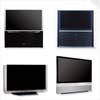Buying the Big Screen
Rear-projection TVs are big, beautiful and bewildering. Which kind is right for you?
We may earn revenue from the products available on this page and participate in affiliate programs. Learn more ›

by From top left: Courtesy Hitachi; Toshiba; RCA; Sony Electronics
When buying a big-screen TV, you can go flat or you can go fat. Flat (with a plasma or direct-view LCD screen) means you can hang your TV on the wall, but you’ll feel the pinch in the checkout lane. In the fat camp are the rear-projection screens, which offer larger screen sizes, great resolution and more affordable prices. Rear-projection TVs will also be the first to be
digital-cable-ready, eliminating the need for a digital-cable box. And the best news of all-they’re not even that fat anymore.
The current crop of rear-projection units comes in four main flavors, each with size, image and price trade-offs: CRT (cathode ray tube), LCoS (liquid crystal on silicon), LCD (liquid crystal display) and DLP (digital light processing). The main thing you care about, though, is how good they look and how much they cost. Use the following guide to figure out which technology will work best for you, your living room and your budget.
CATHODE RAY TUBE
How It Works
The simplest of the bunch: A lens magnifies the light from three individual CRTs-one each for red, green and blue. The beams are then combined to create an image, which a mirror reflects onto a transmissive screen.
Advantages/Disadvantages
Best contrast and color accuracy. Lowest cost per diagonal inch. Jet-black blacks and fine detail in dark areas. Heavy and bulky. Burn-in can be a problem. Limited viewing angle. Highest resolution: 1,440 by 1,080 pixels.
What to Buy
Entry level: Hitachi 51S500 51-inch monitor (shown, $2,300)
High end: Mitsubishi WS-65813 65-inch HDTV ($5,500)
Brightness: 7
Contrast: 9
Color Accuracy: 9
Resolution: 8
Overall picture quality: 8
LIQUID CRYSTAL ON SILICON
How It Works
A prism splits light into red, green and blue beams. Chips process and create an image for each beam, then a lens combines them and magnifies the resulting image, which bounces off a mirror onto a transmissive screen.
Advantages/Disadvantages
No burn-in. Slim cabinet. Largest screen currently available. Blacks not completely black and fine detail may be obscured in dark areas. Bulb must be periodically replaced. Highest resolution: 1,920 by 1,080 pixels.
What to Buy
Entry level: Toshiba 57HL83 57-inch monitor (shown, $5,000)
High end: Mitsubishi WL-82913 82-inch HDTV ($20,000)
Brightness: 6
Contrast: 8
Color Accuracy: 8
Resolution: 10
Overall picture quality: 8
LIQUID CRYSTAL DISPLAY
How It Works
A prism splits light into red, green and blue beams, which travel through individual LCD panels and are then recombined. A lens magnifies the image and reflects it off a mirror onto a transmissive screen.
Advantages/Disadvantages
No burn-in. Slim cabinet. Poor blacks and low-light detail. At larger screen sizes individual pixels may be visible, creating the so-called â€screen door effect.†Highest resolution: 1,386 by 788 pixels.
What to Buy
Entry level: Panasonic PT-50LC13 50-inch monitor ($3,000)
High end: Sony KDF 70XBR950 70-inch HDTV (shown, $7,000)
Brightness: 5
Contrast: 6
Color Accuracy: 6
Resolution: 6
Overall picture quality: 6
DIGITAL LIGHT PROCESSING
How It Works
Light travels through a rotating color wheel with red, green and blue sections and reflects off the DLP chip’s tiny moving mirrors. A lens magnifies the image, which then bounces off a mirror onto a transmissive screen.
Advantages/Disadvantages
No burn-in. Best cabinet-depth-to-screen-size ratio. Blacks not completely black. Lack of detail in dark areas. Bulb needs periodic replacement. Highest resolution: 1,280 by 720 pixels.
What to Buy
Entry level: Samsung HLN4365W 43-inch monitor ($3,500)
High end: RCA Scenium HDLP61W151 61-inch HDTV (shown, $4,500)
Brightness: 6
Contrast: 7
Color Accuracy: 8
Resolution: 6
Overall picture quality: 7
THE BOTTOM LINE
$1,000 to $2,500: Though bulky, CRT-based models deliver the best picture at the low end, with color reproduction rivaling many pricier models. Easily good enough to get by on for a few years.
More than $2,500: With a few more dollars to spend, invest in an LCoS set. They’re skinny, and it’s the only technology to display a true 1080-line picture for crystal-clear HD playback.